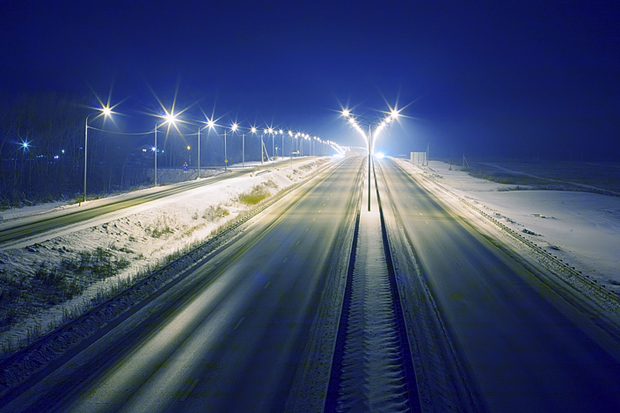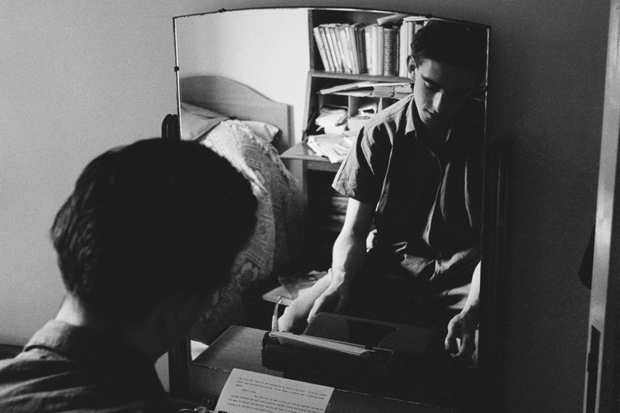‘Trying to determine what is going on in the world by reading newspapers,’ remarked the journalist and screenwriter Ben Hecht, ‘is like trying to tell the time by watching the second hand of a clock.’ He was right, but the fault lies not with the newspapers. The problem arises from the idea of news. ‘News’ cannot see so much of what’s happening that matters.
As the new year begins I’d ask you to consider a small example: the most visible change to the built environment in Britain. I’ve yet to read anything you could call a ‘splash’ on the subject, but gradually, steadily, and in time no doubt universally, we’re losing our yellow-orange ‘sodium’ streetlights, in favour of blue-white LED ones. And because LED is more tightly focused in its illumination, the appearance across the landscape is of thousands of small pools of uncoloured light, instead of one diffuse and generalised orange glow.
In its day, sodium street lighting represented a great advance. It was more energy–efficient, and widely thought to be less displeasing, than the street lighting that I can just about remember: illumination that played tricks with depth of vision and made everyone look green about the gills. So people of my generation would (if they think about it at all) associate orange sodium lights with modernity. Britain was early to embrace sodium. Flying in, I associated those strings of orange lights beneath our wings with home.
Soon they’ll be a thing of the past. Just as sodium lighting once represented an advance in efficiency, so the LED lighting with which local and national government are replacing it offers further gains. LED illumination, being more like spotlighting, can be accurately trained on its target — the ground — rather than surrounding trees and the underbellies of clouds.
I like it; I like the little pools of light, prefer a spectrum closer to daylight, and approve of the energy efficiency. But it is not entirely uncontroversial. There are complaints that road surface gains at the expense of the pavement; complaints about the patchiness; and (from some) complaints that LED light may interfere more with our body clocks.
But there has been almost no public debate: indeed scant public awareness. Britain at night is being turned from blanket fuzzy orange to sharp polka dots of bluey white without anyone being asked. It reminds me of when, over about a decade, all of the black cast-iron flambeaux that once decorated the tops of London’s traffic-light poles like sculpted flaming torches were lopped off without so much as a by-your-leave by the then Greater London Council. No doubt some official Mother Grundy had ruled them a threat to health and safety; but I don’t remember a single report, let alone protest, as familiar street furniture was written out of our metropolitan scene.
All this you may dismiss as my quirkiness. But there’s a change coming that I absolutely know will be remarked upon sadly, decades after the event, but considered (if considered at all) as being of no account as it happens.
If Mrs May’s government is true to its word, we are in for a decade or more of very rapid expansion of the nation’s housing stock. It’s hard to see how Britain can keep up with population growth and satisfy long-pent-up demand without an avalanche of house-building. One way or another — through the private or public sector, or both — millions more homes need to be provided.
The last time this happened on such a scale was in the years after the second world war. The 1930s had seen an explosion of council house-building and ribbon development, of which the ‘three-bedroom semi’ was typical. But after 1945 a Labour government ambitious in its promises bequeathed its 1950s Conservative successors a massive political appetite for more housing. Harold Macmillan made his name as the housing minister who rose to this challenge with a huge programme, particularly of council house-building. Then in the 1960s came high-rise, and the tower blocks that disfigure our urban landscape.
Anyone who, like me, has spent thousands of hours doorknocking and leafleting for a political party will have a keen sense of the urban and suburban residential character of our country. The itinerant hawker is forever finding himself in new territory, and therefore noticing it: seeing it with fresh eyes, as the alien always does.
Almost without exception, the most visually depressing neighbourhoods are housing estates, streets or even whole townships that were put up quickly and at the same time: system-built in order to realise economies of scale and simplify construction. Such house-building has had the wretched effect of turning many ‘estates’ into closed and ill-regarded neighbourhoods: victims of a sort of class apartheid. Almost every village in my county of Derbyshire has ‘the council houses’ usually on the edge or even outside the village.
The strategy is not new: the Georgians and then the Victorians system-built too, but the symmetry and proportions of Georgian housing development are inherently pleasing, and innumerable Victorian terraces have mellowed into something tolerable. Time will not, however, be kind to the big housing schemes and ribbon development of the 20th century.
And the 21st? Today, half a dozen enormous companies dominate the industry. Smaller house-builders who would undertake small projects are down to about a third of their numbers in the 1980s. Most big builders won’t touch the modest, bespoke develop-ment that fills in an empty patch here, a brownfield site there, consolidating and making ingenious use of space.
If — or when — we get the huge surge of house-building we arguably need, most of it will be dismal and unimaginative. But that won’t be an event. It won’t be news. The news will be of targets met, queues cut, families housed. The second hand will be followed with each release of statistics for new housing starts, as ministers crow. The hour hand, however, will be tracing a story of architectural atrocity that only our successors will notice.
Got something to add? Join the discussion and comment below.
Get 10 issues for just $10
Subscribe to The Spectator Australia today for the next 10 magazine issues, plus full online access, for just $10.
You might disagree with half of it, but you’ll enjoy reading all of it. Try your first month for free, then just $2 a week for the remainder of your first year.















Comments
Don't miss out
Join the conversation with other Spectator Australia readers. Subscribe to leave a comment.
SUBSCRIBEAlready a subscriber? Log in